- Project description
- Objectives of the project
- Methods
- Supporting items (team, facilities, instruments, some photos, publications)
- more to be filled later
L I C H E N page of the Department of Plant Physiology and anatomy
PLEASE NOTE: the page is devoted to those people who are involved into ecophysiologyof lichens
- M. BARTAK, Assoc.Prof. (fluorometric methods, gas exchange methods, ecophysiology in the lab/field)
- J. GLOSER, Prof. (Gas exchange methods, spectral reflectance methods, ecophysiology in the lab/field, photoprotective pigments and antioxidants evaluation)
- J. DUBOVA, Dr. (Thallus anatomy of lichens, image analysis)
- O. KOMAREK, Dr. (algologist, cultivation and determination of extracted photobionts)
- P. ILIK, Dr. - Palacky Univ. Olomouc (low/high temperature fluorescence)
- J. HAJEK, Mgr. - Ph.D. student (fluorometric methods, temperature dependence of lichen photosynthesis)
- H. VRABLIKOVA - student (fluorometric methods with respect to lichen photoinhibition)
- I. MUSILOVA - student (foliose lichen anatomy)
- A. KOCMANOVA - student (low temperature effects on lichen physiology)
- see either full list of publication of the staff (including abstract titles from conferences) or
- personal list of publication (only journal publication)
- Lichen physiology-related publications
- Brief characterization of planned
project (2002-2005)
The project is focused on the analysis of photoprotective mechanisms activated in lichen thalli under high light. Those mechanism related to (1) hyphal cortex layer and exclusively to (2) photobiont will be studied separately. Measurements of changes in spectral reflectance with ongoing thalli dessication and determination of amount and role of pigments and fungi secondary metabolits will be done. Photoprotective mechanism related to photobiont will be studied using fluorometric and biochemical methods. We consider application of several fluorometric methods combined with evaluation of the amount of xanthophyll cycle pigments during high light stress induced under laboratory conditions. We expect that photoinhibition of photosynthesis will occur under high light, low temperature and high hydration of studied lichen species. Using fluorometric method, the phenomenon of photoinhibition and recovery from photoinhibition will be studied and limiting factors of photoinhibition will be evaluated. Within the project, also determination of heterogeneity of chlorophyll fluorescence (kinetic CCD camera) and photosynthetic activity (fluorometric and gas exchange methods) will be done in order to quantify the photosynthetic performance of young and old thallus parts. For extrapolation of laboratory results to real outdoor conditions, field measurements of diurnal courses of chlorophyll fluorescence parameters and gas exchange measurements will be made.
Main objectives of planned research
(2002-2005)
The main objective of the proposed project related to
ecophysiology of lichens is to evaluate the extent of
- (1) photoinhibition
(2) mycobiont-related photoprotective mechanism
(3) photobiont-related photoprotective mechanisms
Particular objectives and hypotheses to be proved
- (1)To prove that most severe
photoinhibition in lichens occurs under low temperature and full hydration.
The hypothesis will be tested under laboratory conditions and in the field.
(2) To prove that there is UV-B related photoinhition in lichens.
(3)To prove that the extent of lichen photoinhibition is modulated by selective radiation filtration by the upper hyphal cortex, xanthophyll cycle pigments and antioxidants pools.
(4)To prove intrathalline heterogeneity in actual rate of net photosynthesis and relate it to photobiont amount and distribution.
(5)To prove that under low temperature, there is enhanced negative effect of photoinhibition in PS I compared to PS II.
(6)To prove (combining laboratory and field measurements) that survival strategies of lichens depend mostly on adaptation capability to tolerate extremely low/high temperature.
Team members (+ fields of responsibility)
(1)
Chlorophyll
fluorescence

(0 % of water saturation deficit, WSD) is indicated in green(o), slightly dehydrated thallus is indicated in orange (o), and
violet (o), severe dehydration of thallus (71 % WSD) is indicated in red (o). GP data points were calculated from
quantum yield of photosystem II photochemistry (FII) measured by a fluorometer PAM-2000.
Ref: Hajek-Bartak-Gloser: MS submitted to Photosynthetica.
(2) Pigments
analyses

- (3) Gazometric
methods
(4) Chlorophyll fluorescence imaging
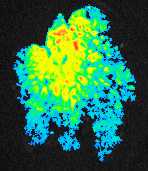 CCD
fluorometric camera image of Lasallia pustulata thallus showing
contrasting
CCD
fluorometric camera image of Lasallia pustulata thallus showing
contrasting
differences of variable fluorescence (Fv) distribution (maximum Fv is found in in central, close-to-umbilicus part of thallus /red, yellow/, minimum Fv is found in marginal parts /deep blue/ - Bartak et Hajek, unpublished).
(5) Anatomy
of lichen thallus
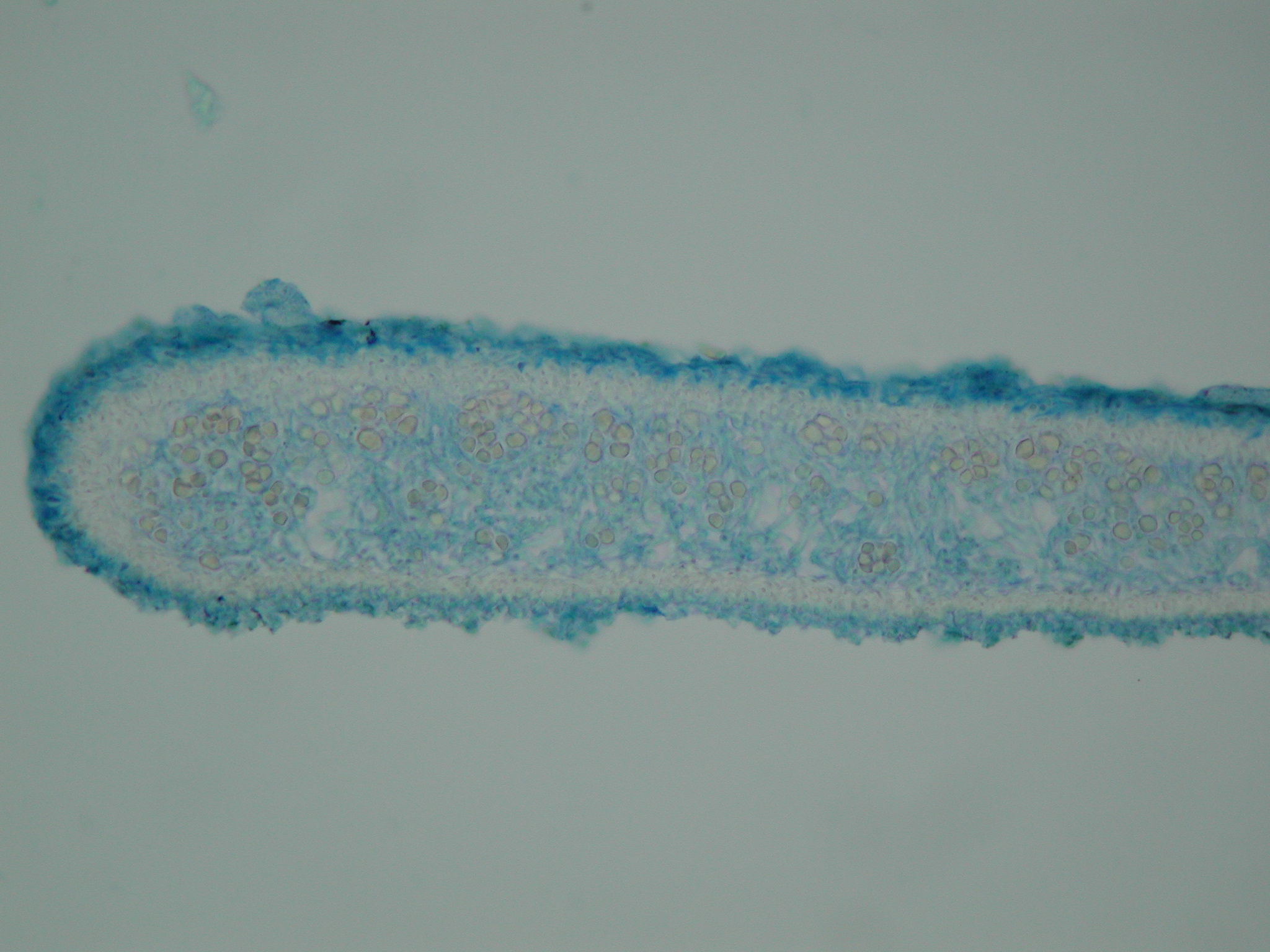
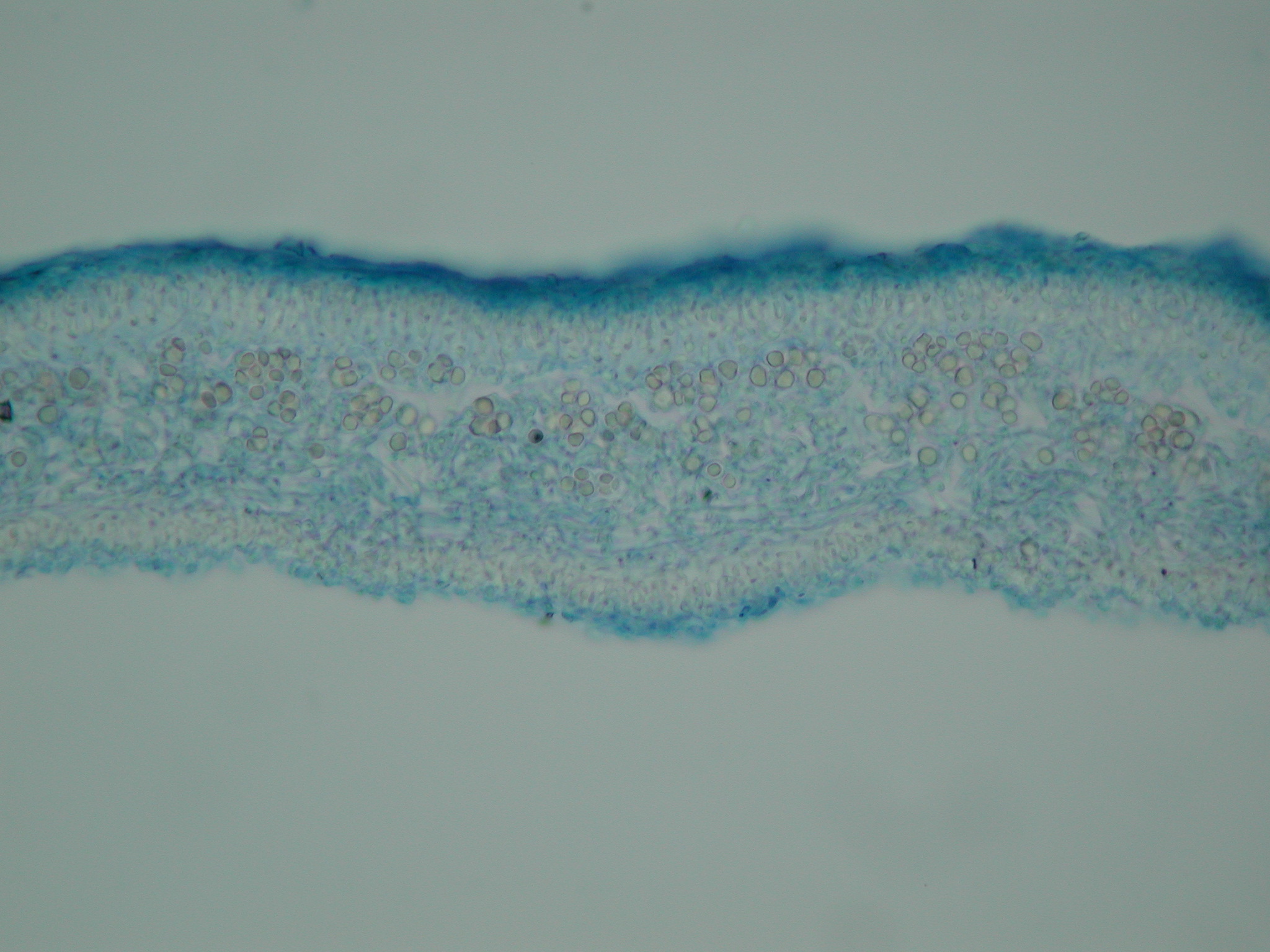 Cross-cut
section of thallus
Cross-cut
section of thallus
of foliose lichen (Hypogymnia physodes) showing /from top to bottom/ 1)upper cortex layer (blue and yellow), 2)Trebouxia cells layer (orange), 3)medulla (yellowish blue), (4)lower cortex (yellow and blue). Source: Dubova et al. (unpublished).
- (6) Cultivation
of extracted photobiont (Trebouxia sp.)
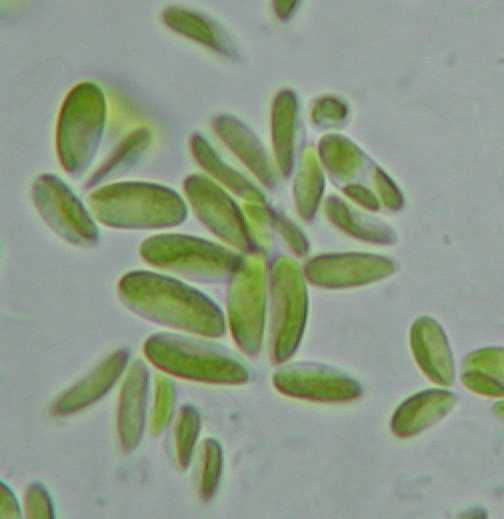
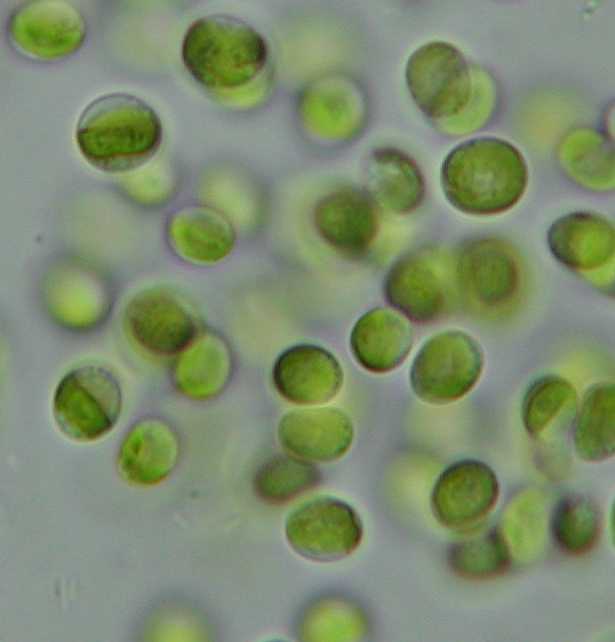
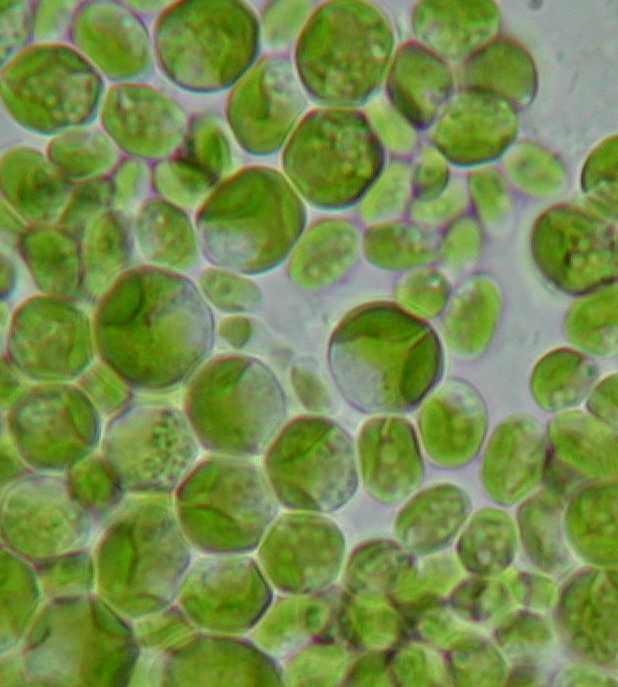
Cells of Trebouxia sp. isolated from Umbilicaria hirsuta at different stages og their reproduction cycle:
left: free swimming zoospores, center: non-motile vegetative cells right: mature cells (the biggest ones)
- Project related to global changes
- 95045 Growth and development of
clonal plants in normal and polluted sites. U.S.-Czech
co-investigators) 1995
- 0757/1998 Effect of global changes
(elevated concentration of CO2) on physiology of plant
Projects related to plant ecology
- 0757/1998 Ecology of antarctic
coastal oasis (P. Prosek - principal investigator, M. Bartak - co-investigator)
1998
- 0606/1996 The Introduction of New
Methods into the Teaching of Photosyntesis. Principal
- 0411/97 Inovation of the Teaching
of Productional Plant Ecology: Modelling of Physiological
and Productional Processes. Principal investigator: Bartak, M., 1997
0462/1999 Modernisation of teachning plant physiology with special respect to photosynthesis.
- Other projects
- 501/94/0493 Ecophysiological Aspects
of Reforestation in Heavily Acidified Environments.
Bartak, M.
- 204/94/0385 Clear-Cut Grass
Vegetation and Soil Interaction Under Different Immision
Institute of Landscape Ecology of the Academy of Sciences and the University of Agriculture and
Forestry, Brno. 1994-1996
- 521/97/0284 Did quantitative parameters
of photosynthetic CO2 fixation and nitrogen
co-investigator, M. Bartak - co-investigator), 1997-1999.
Publications
- Bartak, M., Hajek, J., Gloser, J. (1999): Application
of fluorometric methods to measurements of lichen photosynthetic responses
to changing temperature and thallus hydration. In: Ecology of Antarctic
Coastal Oasis. Book of Abstracts, p. 5.
Bartak, M., Hajek, J., Gloser, J.(2000): Application of fluorometric methods to measurements of lichen photosynthetic responses to changing temperature and thallus hydration. In: Ecology of Antarctic Coastal Oasis. Proceedings, 2000, p. 17-26.
Bartak, M., Hajek, J., Vrablikova, H., Gloser, J. (2000): Photosynthetic response of lichenized Trebouxia sp. (Umbilicaria decussata (Vill.) Zahlbr.) from maritime Antarctica to high light stress. Abstracts. Conference: Algae and Extreme Environments - Ecology and Physiology. Třeboň, Sept 11-16, 2000, Czech Republic, p. 40.
Hajek, J., Bartak, M. (2000): Distributional pattern of unicellular algal photobiont within the thalli of fruticose and foliose lichens. Abstracts. Conference: Prof. Němecs Cytological Day, Brno, May 25, 2000, Czech Republic. p.16.
Hajek, J., Bartak, M., Gloser, J. (2000): Species-specific photosynthetic response of lichens to desiccation and temperature change detected by changes in chlorophyll fluorescence parameters. Abstracts. 12th FESPP Congress, Budapest, August, 2000, Hungary. Plant Physiology and Biochemistry, 38(suppl.): p.193.
Barták, M., Hájek, J., Gloser, J. (2000): Heterogeneity of chlorophyll fluorescence over thalli of several foliose macrolichens exposed to adverse environmental factors: Interspecific differences as related to thallus hydration and high irradiance. Photosynthetica, 38: (accepted, in print).
Hajek, J., Bartak, M., Gloser, J.: Effects of thallus temperature and hydration on photosynthetic parameters of Cetraria islandica from contrasting habitats. Photosynthetica (submitted).
Bartak, M., Dubova, J., Hajková, M., Hajek, J., Musilova, I.: Intrathalline distribution of an alga Trebouxia sp. and its photosynthetic parameters in Lasallia pustulata and Umbilicaria decussata. Abstract. 52nd Conference of the Polish Botanical Society, Poznan, Poland, 2001 (submitted).
Bartak, M., Hajek, J., Vrablikova, H.: Low temperature photoinhibition and recovery in fruticose (Usnea antarctica) and foliose (Umbilicaria decussata) Antarctic lichen species. Abstracts. 9th Days of Plant Physiology, Ceske Budejovice, Czech Republic, 2001 (submitted).
Hajek, J., Bartak, M., Gloser, J.: Photosynthetic response
of Iceland moss (Cetraria islandica) to thallus temperature
and hydration detected by chlorophyll fluorescence. Abstracts. 9th Days
of Plant Physiology, Ceske Budejovice, Czech Republic, 2001 (submitted).